kooio. Innsbruck, 2011
I wanna be Alfred Jarry ....
The Passion considered an uphill bicycle race, or I wanna be Alfred Jarry, 1903/2011, Tyrolian Alps VIDEO 2011
This exhibition contains various elements starting with a daily reading seminar of the texts of Alfred Jarry, a new film entitled T HE PASSION CONSIDERED AN UPHILL BICYCLE RACE, drawings, objects and photographs.
Alfred Jarry Lesen / Reading Alfred Jarry, 2011
three films:
der Uebermann / Supermale , 6 hours
Zwei Kurzgeschichte aus DIE LIEBE AUF BESUCH und DIE PASSION AS BERGRADRENNEN / two short stories from Love on a visit and The Passion as an Uphill bike race, 2 hours
T HE PASSION CONSIDERED AN UPHILL BICYCLE RACE, photog
The Passion considered an uphill bicycle race, or I wanna be Alfred Jarry, 1903/2011, Tyrolian Alps VIDEO 2011
the most romantic blasphemic fairy tale you 've ever seen.. you might even fall in love with a cow
I wanna be Alfred Jarry, objects
T HE PASSION CONSIDERED AN UPHILL BICYCLE RACE, drawings
installation view:


The Passion Considered as an Uphill Bicycle Race or I wanna be Alfred Jarry , 2011
13 drawings, ink on paper, A3 size


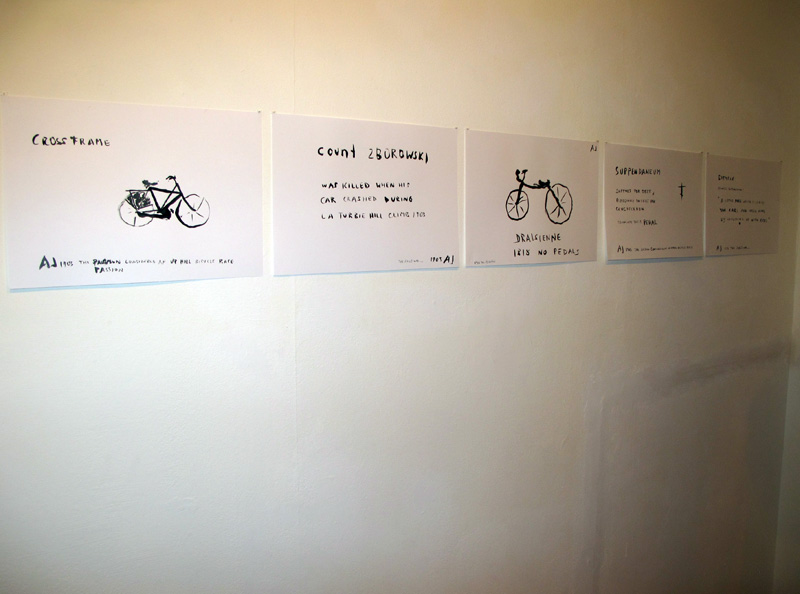
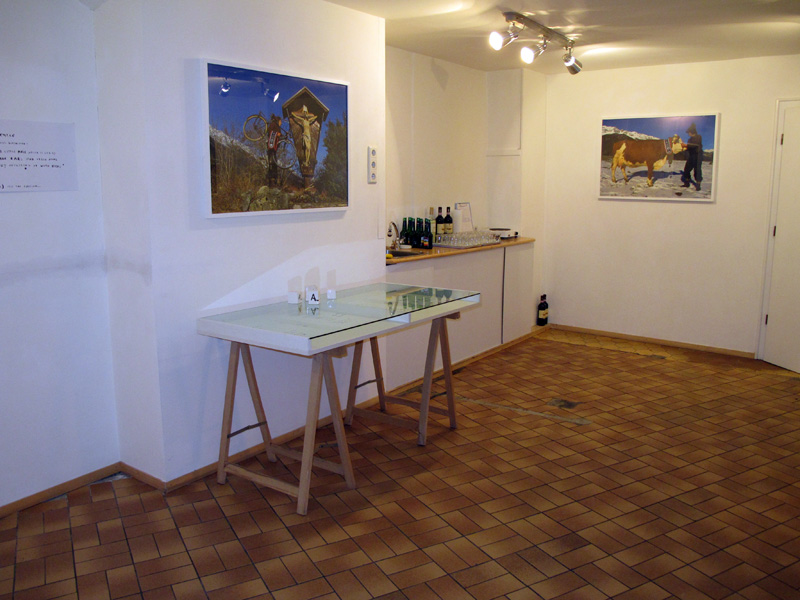
photos 70x 100 cm
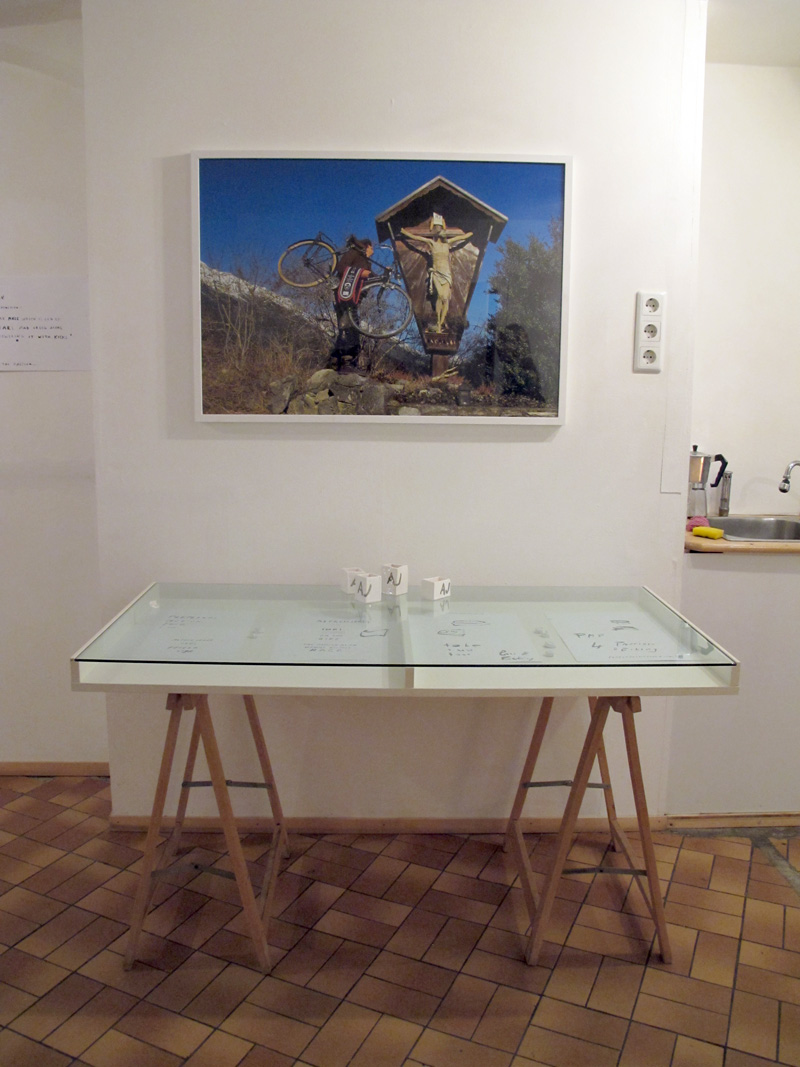

drawings A3


more Perpetual Food Drawings

70 x 100
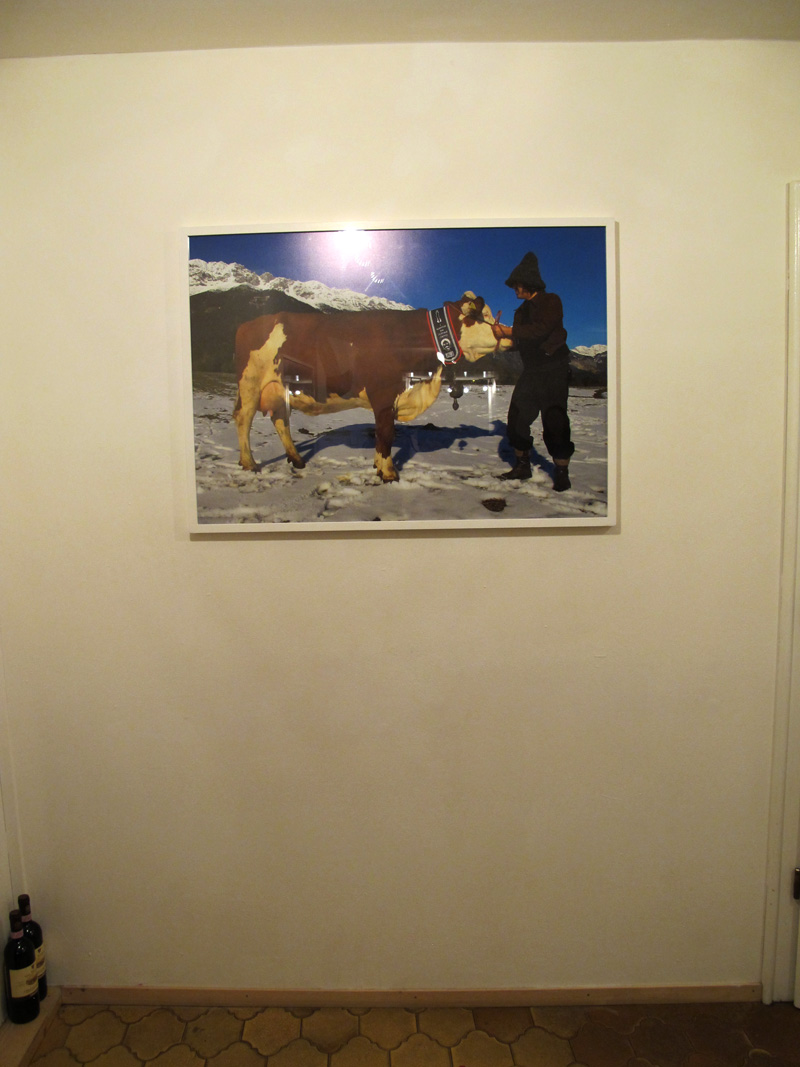










Alfred Jarry Lesen / Reading Alfred Jarry, 2011
work list
The Passion Considered as an Uphill Bicycle Race or I wanna be Alfred Jarry , 2011
video 17 minuten
The Passion Considered as an Uphill Bicycle Race or I wanna be Alfred Jarry , 2011
13 drawings, ink on paper, A3 size
The Passion Considered as an Uphill Bicycle Race or I wanna be Alfred Jarry , 2011
photograph, 70 cm x 100 cm
The Passion Considered as an Uphill Bicycle Race or I wanna be Alfred Jarry , 2011
photograph, 70 cm x 100 cm
The Passion Considered as an Uphill Bicycle Race or I wanna be Alfred Jarry , 2011
photograph, 70 cm x 100 cm
Alfred Jarry Lesen , 2011
photograph, 51 x 61 cm
Alfred Jarry Lesen , 2011
photograph, 51 x 61 cm
Alfred Jarry Lesen , 2011
photograph, 51 x 61 cm
Alfred Jarry Lesen , 2011
photograph, 51 x 61 cm
Alfred Jarry Lesen , 2011
photograph, 51 x 61 cm
Alfred Jarry Lesen , 2011
photograph, 51 x 61 cm
Perpetual Motion Food, take two , 2011
ink on paper, 2 pills
Perpetual Motion Food, take two , 2011
ink on paper, 2 pills
Perpetual Motion Food, take two , 2011
ink on paper, 2 pills
I wanna be Alfred Jarry, dick bell , 2011
ink on paper, A3
I wanna be Alfred Jarry, dick bell , 2011
ink on paper, A3
PERPETUALMOTIONFOOD.COM, Passion, Alfred Jarry, INRI ON THE BIKE , 2011
ink on paper, A3
PERPETUALMOTIONFOOD.COM, PMF, PASSION & BIKING , 2011
ink on paper, A3
PERPETUALMOTIONFOOD.COM, ALFRED JARRY, PFIZER , 2011
ink on paper, A3
PERPETUALMOTIONFOOD.COM, THE PASSION OF CHRIST CONSIDERED AS AN UPHILL BICYCLE RACE , 2011
ink on paper, A3
English text:
The Passion Considered
as an Uphill Bicycle Race
by Alfred Jarry
Barabbas, slated to race, was scratched.
Pilate, the starter, pulling out his clepsydra or water clock, an operation which wet his hands unless he had merely spit on them -- Pilate gave the send-off.
Jesus got away to a good start.
In those days, according to the excellent sports commentator St Mathew, it was customary to flagellate the sprinters at the start the way a coachman whips his horses. The whip both stimulates and gives a hygienic massage. Jesus, then, got off in good form, but he had a flat right away. A bed of thorns punctured the whole circumference of his front tyre.
Today in the shop windows of bicycle dealers you see a reproduction of this veritable crown of thorns as an ad for puncture-proof tyres. But Jesus's was an ordinary single-tube racing tyre.
The two thieves, obviously in cahoots and therefore 'thick as thieves', took the lead.
It is not true that there were any nails. The three objects usually shown in the ads belong to a rapid-change tyre tool called the 'Jiffy'.
We had better begin by telling about the spills; but before that the machine itself must be described.
The bicycle frame in use today is of relatively recent invention. It appeared around 1890. Previous to that time the body of the machine was constructed of two tubes soldered together at right angles. It was generally called the right-angle or cross bicycle. Jesus, after his puncture, climbed the slope on foot, carrying on his shoulder the bike frame, or, if you will, the cross.
Contemporary engravings reproduce this scene from photographs. But it appears that the sport of cycling, as a result of the well-known accident which put a grievous end to the Passion race and which was brought up to date almost on its anniversary by the similar accident of Count Zborowski on the Turbie slope -- the sport of cycling was for a time prohibited by state ordinance. That explains why the illustrated magazines, in reproducing this celebrated scene, show bicycles of a rather imaginary design. They confuse the machine's cross frame with that other cross, the straight handlebar. They represent Jesus with his hands spread on the handlebars, and it is worth mentioning in this connection that Jesus rode lying flat on his back in order to reduce his air resistance.
Note also that the frame or cross was made of wood, just as wheels are to this day.
A few people have insinuated falsely that Jesus's machine was a draisienne, an unlikely mount for a hill-climbing contest. According to the old cyclophile hagiographers, St. Briget, St. Gregory of Tours, and St. Irene, the cross was equipped with a device which they name suppendaneum. There is no need to be a great scholar to translate this as 'pedal'.
Lipsius, Justinian, Bosius, and Erycius Puteanus describe another accessory which one still finds, according to Cornelius Curtius in 1643, on Japanese crosses; a protuberance of leather or wood on the shaft which the rider sits astride -- manifestly the seat or saddle.
This general description, furthermore, suits the definition of a bicycle current among the Chinese: "A little mule which is led by the ears and urged along by showering it with kicks."
We shall abridge the story of the race itself, for it has been narrated in detail by specialized works and illustrated by sculpture and painting visible in monuments built to house such art.
There are fourteen turns in the difficult Golgotha course. Jesus took his first spill at the third turn. His mother, who was in the stands, became alarmed.
His excellent trainer, Simon the Cyrenian, who but for the thorn accident would have been riding out in front to cut the wind, carried the machine.
Jesus, though carrying nothing, perspired heavily. It is not certain whether a female spectator wiped his brown, but we know that Veronica, a girl reporter, got a good shot of him with her Kodak.
The second spill came at the seventh turn on some slippery pavement. Jesus went down for the third time at the eleventh turn, skidding on a rail.
The Israelite deminondaines waved their handkerchiefs at the eighth.
The deplorable accident familiar to us all took place at the twelfth turn. Jesus was in a dead heat at the time with the thieves. We know that he continued the race airborne -- but that is another story.
german text:
Obschon gemeldet, trat Barrabas nicht an. Pilatus, der Starter, nahm sein Wasserchronometer, eine Klepsydra - was ihm die Hände benetzte, sofern er nicht einfach hineingespuckt hatte -, und gab das Abfahrtszeichen. Jesus preschte los.
Damaliger Brauch war es, so der gute Sportredaktor und heilige Matthias, die Radrennfahrer am Start auszupeitschen, wie es heute die Kutscher mit ihren Pferdekräften tun. Geisseln dienen zugleich der Anstachelung wie der gesundheitlichen Massage. In bester Form also fuhr Jesus los, doch die Reifenpanne ereilte ihn sofort. Eine Dornstrauchpflanzung hatte sein Vorderrad rundum durchlöchert. In Schaufensterauslagen von Zweiradfabrikanten ist derzeit ein exaktes Abbild dieses wahrhaften Dornenkranzes zu sehen: als Werbung für pannensichere Reifen. Der von Jesus, ein gewöhnlicher Single-Tube- Bahnrenner, war es nicht. Die beiden Räuber, die gemeinsame Sache machten, gewannen Vorsprung. Dass dabei Nägel im Spiel gewesen seien, ist unwahr. Die drei in Bildern gezeigten sind sogenannte Rapid-Reifenheber. Aber zuvorderst sollten wir von den Stürzen berichten; und in wenigen Worten die Maschine beschreiben.
Der moderne Fünfeckrahmen ist eine vergleichsweise junge Erfindung. Um 1890 sind die ersten Fahrräder dieser Art aufgekommen. Zuvor bestand das Gestell der Maschine aus zwei lotrecht aufeinander gelöteten Rohren. Man sprach von Langwied-Maschinen oder auch von einem Kreuzrahmen-Rover. Insofern stieg Jesus nach seiner Reifenpanne den Berg zu Fuss hinauf und nahm sein Gestell oder, wenn man so will, sein Kreuz auf die Schultern. Nach Fotografien gefertigte Stiche der Zeit stellen die Szene dar. Aber offenbar wurde der Radsport infolge des wohlbekannten Unfalls, der das Passionsrennen auf so missliche Art beendete (fast auf den Jahrestag genau hat ihm vor kurzem der gleichartige Unfall des Grafen Zborowski an der Steigung von La Turbie Aktualität verschafft), offenbar wurde dieser Sport durch Erlass des Präfekten für eine Zeit lang verboten. Was erklärt, dass die illustrierten Blätter bei der Wiedergabe der berühmten Szene recht phantastische Fahrräder abbildeten. Sie verwechselten das Kreuz des Korpus der Maschine mit jenem anderen Kreuz: der geraden Lenkstange. Und stellten Jesus mit auf seinem Lenker ausgebreiteten Armen dar, was uns zu der Bemerkung veranlasst, dass Jesus zur Verringerung des Luftwiderstandes liegend auf dem Rücken pedalierte. Gleichfalls anzumerken ist, dass der Rahmen, oder das Kreuz, seiner Maschine, wie heutzutage mancherlei Felge, aus Holz hergestellt war.
Zu Unrecht wurde behauptet, Jesus' Maschine sei eine Draisine gewesen, ein für Bergrennen, zum Anstieg, recht unwahrscheinliches Gefährt. Den alten zyklophilen Hagiographen gemäss, der hl. Brigitte, dem Gregor von Tours und dem Irenäus, war das Kreuz mit einer Vorrichtung ausgestattet, die sie als «suppedaneum» bezeichnen. Es bedarf hier keines grossen Klerikers, um dies mit «Pedal» zu übersetzen.
Justus Lipsius, Justinus, Bosius und Erycius Puteanus beschreiben ein weiteres Zubehör, das man noch, wie 1634 Cornelius Curtius berichtet, an gewissen «Kreuzen» aus Japan vorfindet: eine hölzerne oder lederne Ausstülpung des Kreuzes oder Rahmens, auf die sich Radler und Radlerinnen rittlings setzen: offenbar der Sattel. Im Übrigen sind diese Beschreibungen nicht weniger getreu, als wenn heute Chinesen ein Fahrrad definieren: «kleines Maultier, das an den Ohren gelenkt und zur Fortbewegung mit Fusstritten eingedeckt wird».
Den Bericht vom Rennen selbst kürzen wir ab; es ist in ganzer Länge in Fachbüchern wiedergegeben und in der Bildhauerkunst und Malerei durch eigens zu diesem Behuf geschaffene Werke dargestellt. Vierzehn Kurven gibt es auf dem ziemlich harten Anstieg des Golgatha. Jesus stürzte zum ersten Mal in der dritten. Seine Mutter ängstigte sich auf der Tribüne. Der gute Schrittmacher Simon aus Kyrene, der Jesus - wäre es nicht zur Panne mit den Dornsträuchern gekommen - hätte losziehen und ihm Windschatten geben sollen, trug die Maschine. Jesus trug nichts und schwitzte trotzdem. Ungewiss ist, ob ihm eine Zuschauerin das Gesicht abgetrocknet, aber zutreffend ist, dass die Reporterin Veronika eine Momentfotografie mit ihrer Kodak aufgenommen hat. Zum zweiten Sturz, in der siebenten Kurve, kam es auf schlammigem Grund. Und auf einer Schiene schleuderte Jesus ein drittes Mal in der elften. In der achten winkten Damen aus der Halbwelt Israels mit ihren Tüchern. Der bedauerliche Unfall, der weithin bekannt wurde, ereignete sich in der zwölften Kurve. Zu diesem Zeitpunkt war das Rennen «tot», Jesus «deadhead» mit den beiden Räubern. Dass er das Rennen als Luftfahrer fortsetzte, ist ebenfalls bekannt. Aber das gehört zu einem anderen Gebiet.
----------
french text
gefördert durch
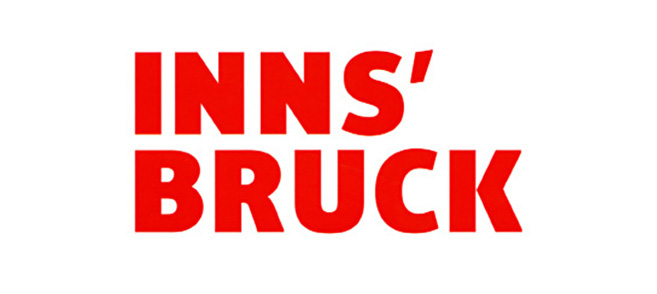

BOZEN KUNSTMESSE










